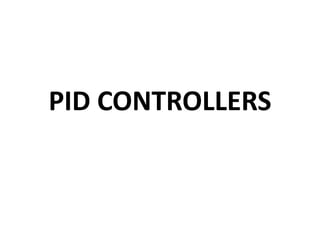
Optimize PID Controllers with Proportional, Integral and Derivative Actions
- 3. ▪ A sensor measures and transmits the current value of the process variable, PV, back to the controller (the 'controller wire in') ▪ Controller error at current time t is computed as set point minus measured process variable, or e(t) = SP – PV ▪ The controller uses this e(t) in a control algorithm to compute a new controller output signal, CO ▪ The CO signal is sent to the final control element (e.g. valve, pump, heater, fan) causing it to change (the 'controller wire out') ▪ The change in the final control element (FCE) causes a change in a manipulated variable ▪ The change in the manipulated variable (e.g. flow rate of liquid or gas) causes a change in the PV
- 4. PROPORTIONAL ONLY MODE The P-Only Algorithm - The P-Only controller computes a CO action every loop sample time T as: CO = CObias + Kc∙e(t) Where: • CObias = controller bias or null value • Kc = controller gain, a tuning parameter • e(t) = controller error = SP – PV • SP = set point • PV = measured process variable
- 7. DEFINITIONS – CObias is the value of the CO that, in manual mode, causes the PV to steady at the DLO while the major disturbances are quiet and at their normal or expected values. Control loop sample time specifies how often the controller samples the measured process variable (PV) and computes and transmits a new controller output (CO) signal. OFFSET – The difference between process value (PV) and set point (SP) when the controller output has already settled. Proportional Band – PB = (COmax – COmin)/Kc When CO and PV have units of percent and both range from 0% to 100%, the much published conversion between controller gain and proportional band results: PB = 100/Kc
- 8. ADVANTAGES– 1. Only one variable, gain Kc has to be controlled to control the response of the system 2. Relatively simple to design 3. Works well for systems where set point doesn’t change DISADVANTAGES – 1. Offset is produced if set point is changed from design value. 2. If proportional gain is increased to reduce the offset, the system becomes unstable.
- 9. THE PI MODE • The PI Algorithm • While different vendors cast what is essentially the same algorithm in different forms, here we explore what is variously described as the dependent, ideal, continuous, position form: Where: • CO = controller output signal (the wire out) • CObias = controller bias or null value; set by bump-less transfer as explained below • e(t) = current controller error, defined as SP – PV • SP = set point • PV = measured process variable (the wire in) • Kc = controller gain, a tuning parameter • Ti = reset time, a tuning parameter
- 12. • ADVANTAGES – 1. It eliminates offset produced due to proportional control 2. Accelerates the response towards steady state DISADVANTAGES – 1. It may lead to sustained oscillations about the set point 2. The two tuning parameters interact with each other and their influence must be balanced by the designer which is more complex than p only. 3. The integral term tends to increase the oscillatory or rolling behavior of the process response.
- 13. PID CONTROL The Dependent, Ideal PID Form A popular way vendors express the dependent, ideal PID controller is: Where: CO = controller output signal (the wire out) CObias = controller bias; set by bump-less transfer e(t) = current controller error, defined as SP – PV SP = set point PV = measured process variable (the wire in) Kc = controller gain, a tuning parameter Ti = reset time, a tuning parameter Td = derivative time, a tuning parameter
- 14. • The proportional term considers how far PV is from SP at any instant in time. Its contribution to the CO is based on the size of e(t) only at time t. • The integral term addresses how long and how far PV has been away from SP. The integral term is continually summing e(t). • A derivative describes how steep a curve is. More properly, a derivative describes the slope or the rate of change of a signal trace at a particular point in time.
- 17. DERIVATIVE KICK • When the controller begins operation, the slope of the controller response is almost 90 degrees and thus the derivative term produces a huge output (theoretically infinity).This is known as a Derivative kick and is mostly undesirable. • To overcome this, instead of taking derivative of error voltage, we take the derivative of the process value(PV).
- 18. • When set point is constant, its derivative is zero. So we can write the differential term as – So we can write the PID control equation as –